A Step-by-Step Guide to Creating a Cognitive Training Plan
This guide aims to simplify this complex process, providing step-by-step guidance for designing an impactful cognitive training plan.

Initiating cognitive training requires a strategic approach. Designing a plan that effectively targets the individual's specific needs, while also keeping them engaged and challenged, is both an art and a science. The process can be intricate, with numerous factors to consider, such as the individual's current cognitive strengths and weaknesses, the sport's demands, and the available training tools and techniques. This guide aims to simplify this complex process, providing step-by-step guidance for designing an impactful cognitive training plan.
Historical methods of cognitive training: In the past, cognitive training was primarily based on a set of standardized tasks that individuals would repeatedly practice. Coaches and trainers would select tasks based on general understanding and sometimes even intuition, with limited options for customization. The focus was often on finding new and more difficult tasks rather than tailoring the tasks to the specific needs and goals of the individual.
The repetitive nature and limited flexibility of traditional methods: This traditional approach often resulted in repetitive training sessions. Individuals would undergo similar routines without much variation, leading to potential stagnation in progress. Furthermore, the lack of flexibility meant that as individuals progressed or their needs changed, the training might not evolve correspondingly. In essence, while the traditional methods served as a foundational approach to cognitive training, they had their limitations in terms of adaptability, engagement, and effectiveness.
The New Era of Cognitive Training: While traditional methods laid the groundwork for cognitive training, Soma introduces a new era of cognitive training, marked by dynamic adaptability and precise personalization. No longer confined to static tasks, individuals can now benefit from tasks that can be continually adapted.
The true strength of cognitive training lies in its adaptability. With Soma, we're no longer restricted to one-size-fits-all tasks. Instead, we can mold and shape tasks to meet the specific needs and challenges of each individual. Much like the foundational exercise of the barbell bench press in physical training, cognitive tasks can be seen as foundational building blocks. The bench press, in its most basic form, seems straightforward. Yet, by introducing variations like tempo changes, resistance bands, chains, or even unstable elements like hanging plates, the exercise transforms, offering increased challenges and benefits. Similarly, with the capabilities of Soma Analytics, foundational cognitive tasks can undergo transformative adaptations, maximizing their impact.
Now that we have clarified how Soma allows you to customize tasks with a high level of specificity, let's move on to designing a cognitive training plan with Soma Analytics.
Cognitive Demands
Cognitive demands refer to the specific mental capabilities or outcomes that one aims to develop or strengthen. By emphasizing cognitive demands, you can more easily select the most suitable tasks to achieve desired outcomes. Simply choose the demand and then select tasks that train that specific demand. This streamlines the process, allowing you to filter out irrelevant tasks more efficiently instead of sifting through a multitude of options.
Cognitive Demand | Description |
Memory | Memory refers to the ability to hold and use information consciously. |
Attention | Attention involves focusing mental awareness on relevant environmental cues and maintaining concentration. |
Response Inhibition | Response Inhibition refers to the ability to suppress inappropriate, irrelevant, or suboptimal actions. |
Decision-Making | Decision-making is the process of selecting an option or course of action from several alternatives. |
Once you have decided on the cognitive demands you want to focus on the upcoming plan, the next step is to conduct a baseline test.
Baseline
To effectively measure an individual's current cognitive capacities, it is recommended to start with a baseline test tailored to the individual's needs.
Here is a structured approach to set up this foundational assessment:
1. Test Duration: The length of the baseline test is crucial. We suggest a duration no shorter than 30 minutes to ensure a comprehensive assessment. A test that's too brief might result in sparse data collection, potentially affecting the quality of results and impeding informed decision-making. Additionally, a baseline test that's too short may not sufficiently challenge the athlete, resulting in an inaccurate assessment of their capabilities.
2. Task Selection: Choose between three to six tasks that align closely with the cognitive demands you want to target. These tasks will form the essence of your baseline assessment. Avoid overthinking this step, as your main objective is simply to gather data for each cognitive demand you want to focus on for the current program.
Cognitive Tasks
Below is a list of cognitive tasks, categorized by their main cognitive demand. While each task involves multiple skills, the classification emphasizes the most significant one.
💬 Voice Command Task
✋ Right Hand
🤚 Left Hand
Attention (26 Tasks)
- PFTT
- Posner
- Double Mackworth
- Recovery
- PVT-B
- Attention Switching
- 0 Back
- AX-CPT 💬
- Congruent Stroop Test 💬
- Dynamic Fusion
- Anticipation
- Congruent Stroop Test
- Box Breathing
- PVT
- Fusion
- Detailed Vision Zone 🤚
- Detailed Vision Zone ✋
- Time Perception
- Eye Hand Coordination
- Multi Object Training
- AX-CPT
- Mackworth Clock
- RVIP
- 4 Choice Reaction
- Audio Reaction Test
- Visual Reaction Test
Inhibition (39 Tasks)
- Spatial Stroop
- Dots Task
- cMSIT
- Simon Task
- Flanker Compatibility
- MSIT
- Incongruent Flanker 💬
- MSIT 💬
- Switched Attention Test 💬
- Numerical Inhibition 💬
- Visual Choice Go No Go 💬
- Inverted Stroop Test 💬
- Stroop Test 💬
- Go No Go Visual Test 💬
- Numerical Inhibition
- AV Choice Go No Go
- Visual Choice Go No Go
- Audio Choice Go No Go
- Sustained Attention
- Incongruent Flanker
- Switched Stop Audio
- Switched Stop Visual
- Inverted Stroop Test
- Audio Stop Signal
- Visual Stop Signal
- Tactile Motor Go No Go 🤚
- Tactile Motor Go No Go ✋
- Dynamic Vision Trainer
- AV Motor Go No Go 🤚
- AV Motor Go No Go ✋
- Audio Motor Go No Go 🤚
- Audio Motor Go No Go ✋
- Visual Motor Go No Go 🤚
- Visual Motor Go No Go ✋
- Switched Attention Test
- Stroop Test
- Go No Go Audio Test
- Go No Go Visual Test
- Visual Inhibition
Decision (7 Tasks)
- AV Choice 💬
- Visual Search
- AV Choice
- Audio Choice Test
- Visual Choice Test
- Audio Choice Test
- Visual Choice Test
Memory (12 Tasks)
- 4 Choice Flanker
- Colour Shape Task
- PVSAT
- Visual Digit Span
- 2 Back
- TLDB
- PASAT 💬
- PASAT
- Task Switching 💬
- Spatial Span
- Tachistoscope
- Task Switching
3. Data Analysis: After the individual completes the baseline test, analyze the data to start creating a training plan based on their performance. Focus on areas where they show difficulty. Depending on their needs, you might concentrate solely on one specific cognitive demand or balance several. For example, if an individual excels in decision-making but struggles with inhibiting responses, incorporate more tasks focused on inhibition than those on decision-making in their training. They could undertake two inhibition tasks for every decision-making task. This approach not only maintains their strengths but also improves weaker areas, equipping them mentally to tackle a variety of challenges.
Component | Description |
Test Duration | Suggested minimum duration is 30 minutes. The duration is crucial for ensuring a comprehensive assessment. Shorter tests might result in sparse data, affecting the quality of the results and decision-making. Too brief tests may not adequately challenge the individual, leading to an inaccurate assessment of their capabilities. |
Task Selection | Choose between 3 to 6 tasks that align closely with the cognitive demands you want to target. These tasks form the essence of the baseline assessment. The main objective is to gather data for each cognitive demand in focus for the current program, without overcomplicating the process. |
Data Analysis | After the individual completes the baseline test, analyze the data to create a training plan based on their performance. Focus on areas of difficulty. Depending on their needs, the training might concentrate on one specific cognitive demand or balance several. For example, if an individual struggles with inhibiting responses but excels in decision-making, incorporate more tasks focused on inhibition in their training. |
Task Selection
With the foundational data gathered, it's time to design the cognitive training program. This stage can feel like navigating a vast, unfamiliar forest due to the plethora of cognitive tasks available. This abundance of choices makes the process exciting, but it can also be overwhelming, especially for those new to this field. The key isn't to find the "best" task universally, but rather to select the "right" one that aligns with the specific goals of the individual.
Using Soma simplifies this process. When you start with a task, if it turns out to be less challenging than needed, there's no need to discard it completely. Instead, you can modify its difficulty level or utilize one of Soma's unique training modes to customize it to the user's requirements.
In the past, if a task didn’t sufficiently challenge the user, the typical response was to look for a completely new task targeting the same cognitive function, replacing the one that wasn't effective. However, with Soma, you have the flexibility to take the existing task and enhance it using a specialized mode to increase its cognitive load. This allows for a more tailored approach, ensuring that the training remains relevant and challenging. We will delve into this in greater detail in the subsequent step.
As previously emphasized, it's important to tailor your approach based on the specific areas where the individual faces challenges. Depending on their unique needs, you might concentrate on improving a single cognitive demand or balance the training across several demands. This personalized approach ensures the cognitive training is effective and relevant to the individual's requirements.
⚠️ We recommend selecting 10-16 cognitive training tasks per training program.
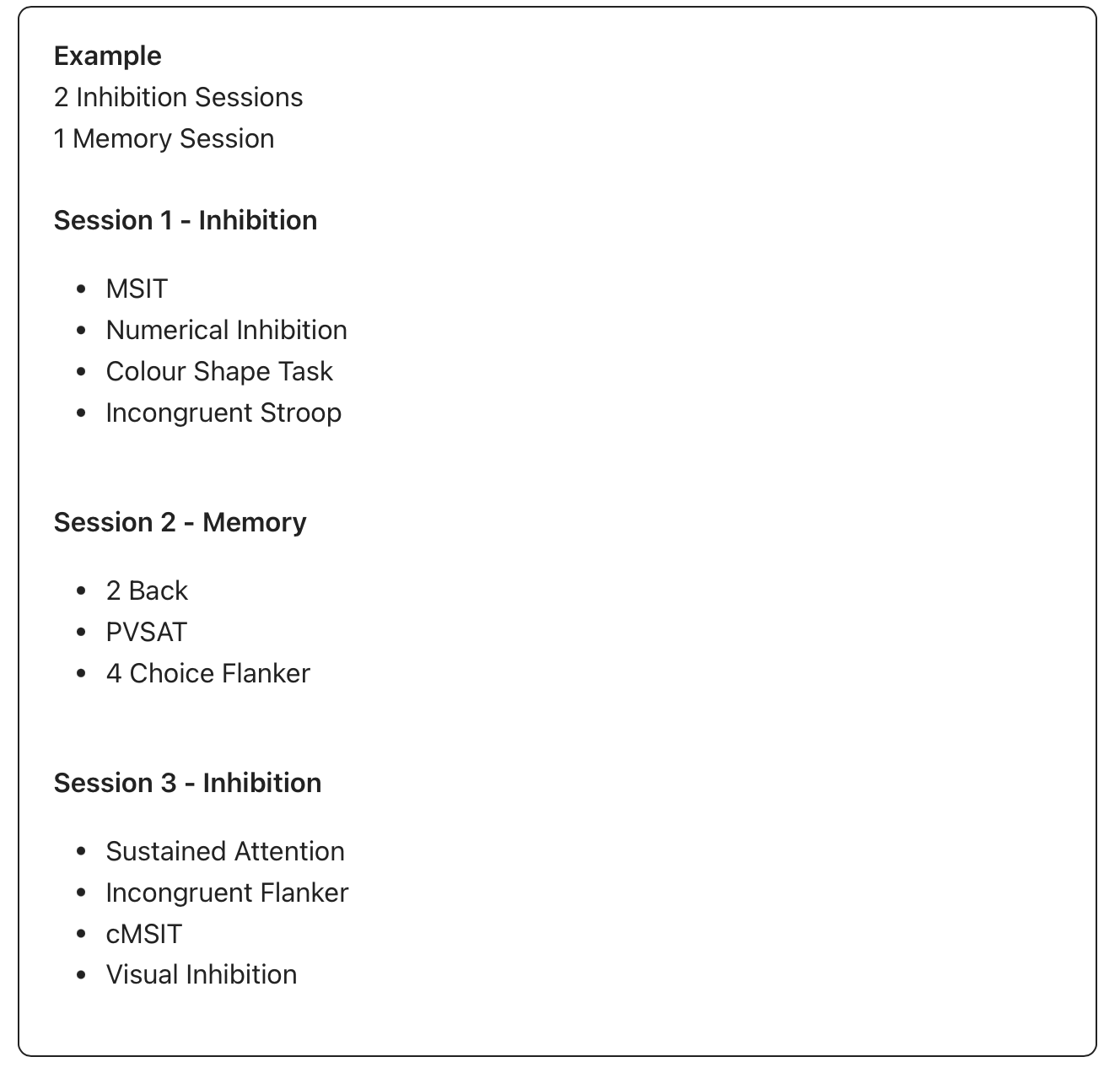
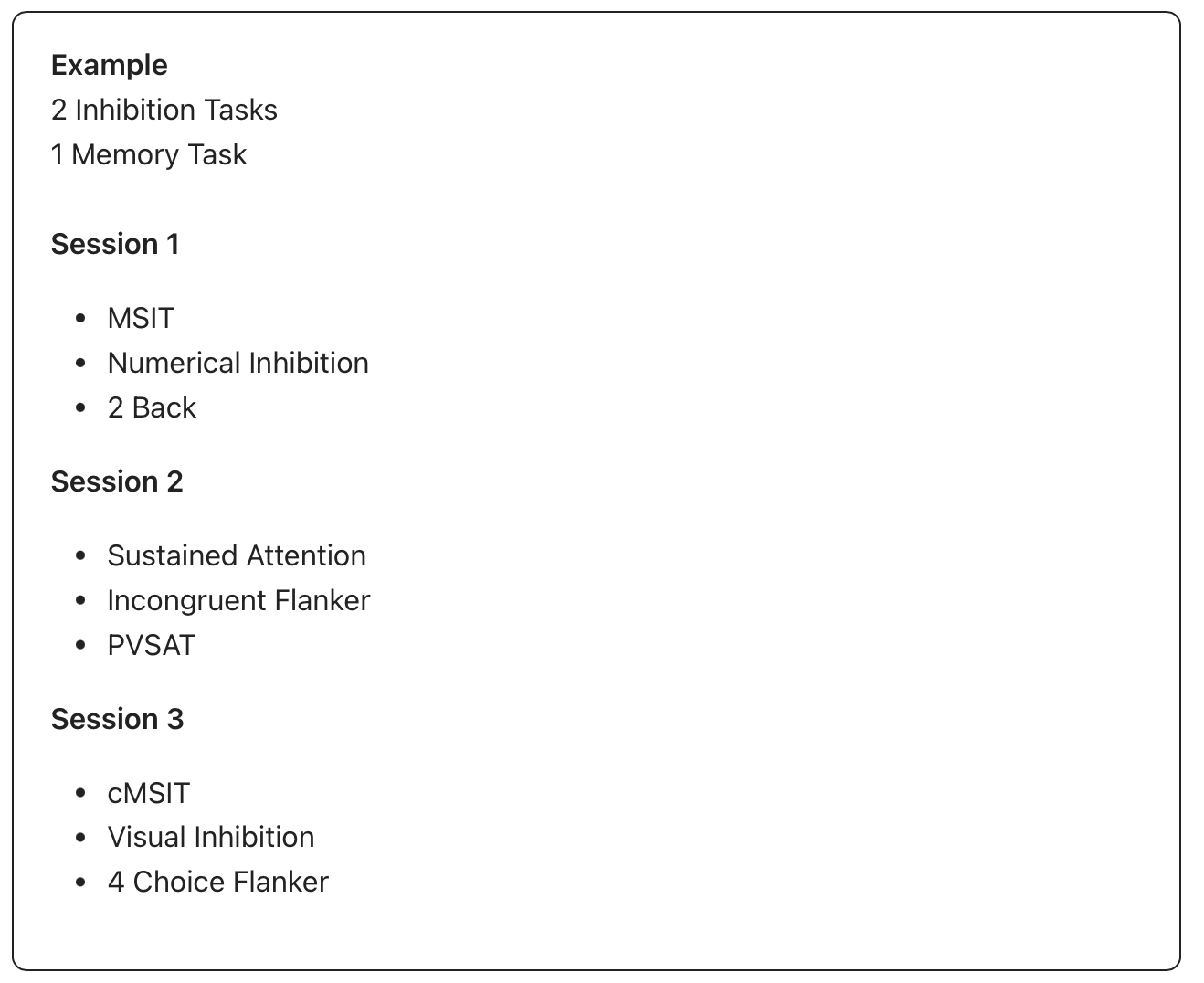
Customisation
Building on the selection of tasks, the true transformation in cognitive training arises when you meticulously adapt these tasks to meet the specific challenges and needs of the individual. With Soma, this level of customization isn't just an added feature; it's a fundamental aspect of the approach. Whether it's adjusting the task's complexity or merging it with physical challenges, the customization possibilities are vast and game-changing.
To facilitate this, we provide a comprehensive chart outlining various modes that can be integrated into cognitive training tasks. These modes are designed to ensure that each training session is personalized. For achieving the best outcomes, it's recommended to incorporate 1-3 of these modes into each training cycle. By doing so, the cognitive training plan becomes highly tailored, perfectly aligning with the individual’s unique requirements.
As you proceed with developing a customized training regimen, it’s essential to ground your decisions in data. Monitoring metrics such as reaction times, accuracy, and variability is crucial. These metrics serve as key indicators of the effectiveness of your chosen tasks. This data-driven approach affords you the flexibility to either tweak the training plan for better alignment or to continue with the current trajectory if it proves effective. Should a task prove insufficient in terms of cognitive load, the first step should be to modify it using one of the modes, instead of immediately looking for a replacement. This method ensures a more efficient and targeted approach to cognitive development.
Mode | Description | Key Points |
Audiovisual Modes | Offers real-time feedback on performance. | Shapes decision-making behavior. Use for feedback or influencing decision-making. |
EDM Mode | Enhances error detection and monitoring. | Measures reaction time post-error. Longer EDM reaction time suggests deliberate error correction. Reducing gap between regular and EDM reaction time indicates improvement. |
CSQ Mode | Enhances mental resilience. | Red timer bar indicates an error, adding 15s penalty. Further errors add more penalties. |
DRT Mode | Evaluates cognitive effort and attentional resources. | Slower DRT reaction time indicates high cognitive load, while faster indicates low load. |
TTE Mode | Increases cognitive challenge over time. | Begins with a 3-min test. Task ends if reaction time exceeds a set threshold. |
VPF Mode | Enhances reaction time, concentration, and consistency. | Encourages a response time variation of -/+ 10% for correct responses. |
ADM Mode | Adjusts cognitive challenge based on performance. | Aligns tasks with current cognitive capacity. |
HRZ Mode | Maintains a specific heart rate zone during training. | Pauses task if heart rate deviates from the zone. |
CEM Mode | Integrates heart rate into the cognitive task. | Requires physical exertion to reach a target heart rate. |
AHR Mode | Guides users through heart rate zones during training. | Pauses task if heart rate deviates from the zone. |
AHV Mode | Adjusts based on heart rate variability (HRV). | Challenge rises with increasing HRV and decreases as HRV drops. |
TSM Mode | Introduces a secondary cognitive task. | 'Task-switching' challenge that evaluates cognitive agility. |
DPM Mode | Monitors shifts in performance, providing feedback on declines. | Pink feedback bar indicates a performance drop; its length varies with the degree of decline. |
PCM Mode | Requires a sprint after each incorrect response. | Heart rate must reach Zone 4 and stay for 5s+ after each error. |
TPM Mode | Introduces time constraints to responses. | Imposes time pressure. Increases pressure as user improves. |
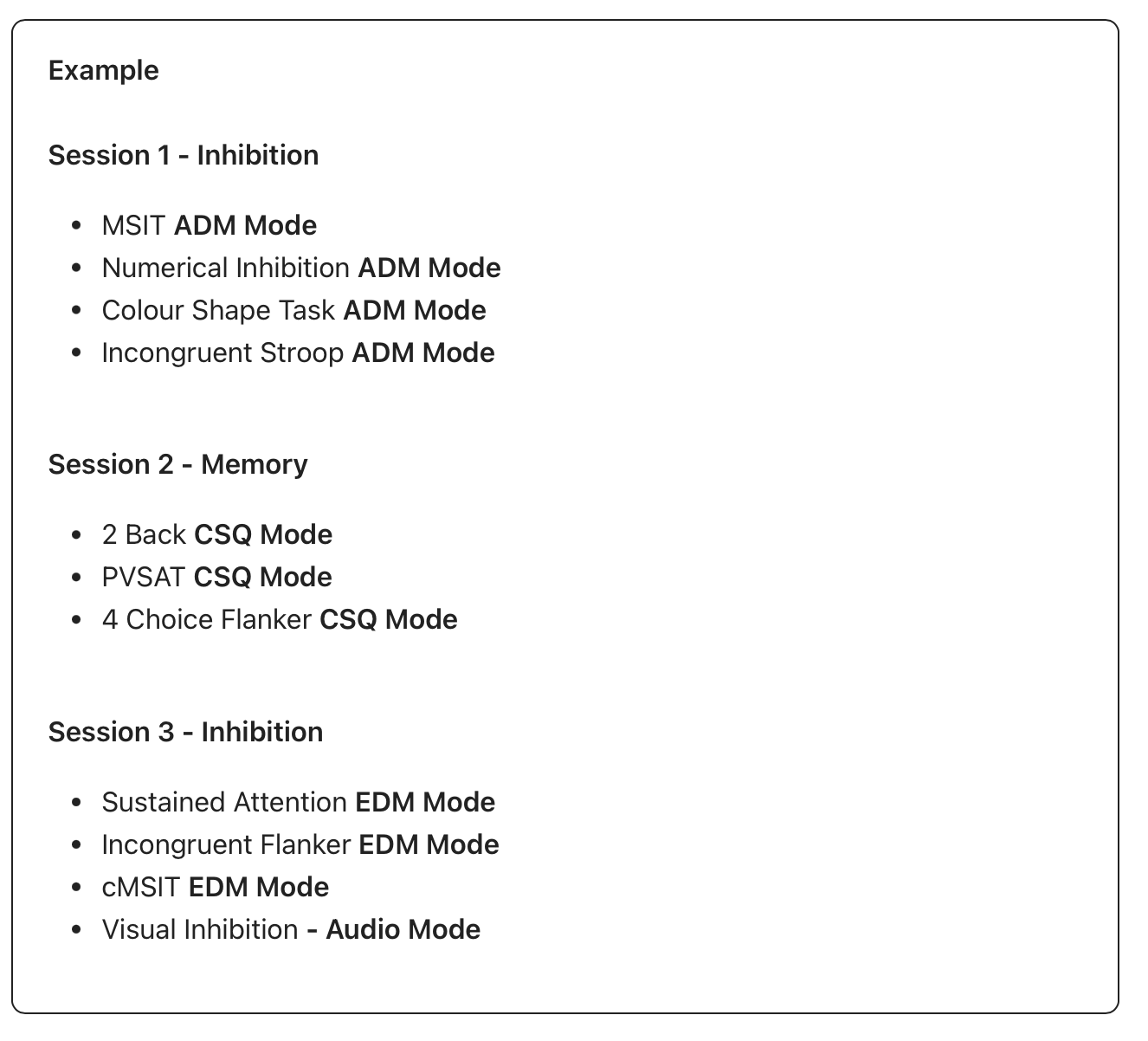
Integration
Before to moving into the periodization phase of the cognitive training plan, it's imperative to select the appropriate strategy for incorporating Soma into your athletes' training schedules. A range of methods is available, each of which can be tailored to meet the specific needs of each athlete. Below, we have outlined all available methods along with recommended tasks per session, the duration of these tasks, session lengths, and the frequency of sessions:
Pre-Training
Engaging in cognitive tasks before physical exercises heightens perceived effort, pre-fatiguing the brain and amplifying the intensity of the physical training that follows.

Intermittent
Incorporating cognitive tasks between physical training sets serves as an effective form of active rest, enhancing the total workload of the session.

Concurrent
Combining cognitive exercises with maintaining specific heart rate zones during warm-ups, cool-downs, or cardio sessions is ideal for time efficiency, rehabilitation for injured individuals, or merging cardiovascular with cognitive training.

Post-Training
Conducting cognitive training after physical workouts challenges individuals mentally, capitalizing on the fatigue from their initial training. This approach is excellent for those who prefer not to interfere with the physical training session.

Periodisation
Now that you've assembled all the necessary components, the next step is periodization. This entails organizing the cognitive tasks you've chosen in a manner that each session or week is progressively more challenging than the last. We'll delve into two straightforward periodization methods. Within these methods, there are various strategies you can tailor based on individual requirements.
Progressive Overload
Progressive Overload, is a concept widely recognized in physical training. While traditionally linked to the gradual increase of weights in resistance exercises, its application in cognitive training emphasizes a consistent escalation of cognitive load to create adaptations in the brain.
Here are three methods to achieve progressive overload, allowing you to increase the overall load each week. You can choose to use one method or combine multiple methods for optimal results.

Intensity Progression Over Weeks
Week | Intensity (%) |
1 | 70 |
2 | 80 |
3 | 90 |
4 | 100 |

Session Duration Increment Over Weeks
Week | Session Duration (minutes) |
1 | 10 |
2 | 20 |
3 | 25 |
4 | 30 |

Frequency of Training Sessions Over Weeks
Week | Number of Sessions |
1 | 2 |
2 | 3 |
3 | 4 |
4 | 5 |
To summarize, you can adopt a single strategy or merge one or two strategies for progressive overload. The paramount objective is to ensure that each subsequent week presents a greater challenge than the previous one.
Undulating Periodization
Undulating periodization is a training model that emphasizes the regular and systematic variation of intensity and volume within short cycles, either daily or weekly. Contrary to traditional models, which might emphasize a linear progression or consistent phases of training, undulating periodization introduces waves of training intensities.
Dynamic Adaptation: By constantly fluctuating the intensity and volume, individuals are perpetually adapting. This ensures they don't hit plateaus or get too comfortable in their routine.
Diverse Stimulus: Athletes receive both high-intensity, low-volume training and low-intensity, high-volume training within a short period. This varied stimulus can foster multifaceted development, both physically and mentally.
Micro-cycles: These are short, frequently changing cycles (often weekly or daily) that provide a mix of intensity and volume. This offers the athlete a chance to recover and adapt quicker than longer cycles.
For undulating periodization to be effective, understanding and manipulating the core variables of training is essential. Here are insights on fine-tuning the stimulus.

It isn't merely a matter of high versus low intensity; it's about grasping the cognitive strain a task places on an individual. Within the realm of undulating periodization, intensity isn't fixed. Purposeful fluctuations between intensities aim to emulate the unpredictable demands of real-world sports.
Consider a soccer player: they might confront high-intensity scenarios during a pivotal match segment and experience more moderate moments during routine plays. Training needs to echo these variances.
Daily Variation of Task Intensity over a Week
Days of the Week | Task Intensity Level (%) |
Monday | 10 |
Tuesday | 80 |
Wednesday | 30 |
Thursday | 70 |
Friday | 20 |
Saturday | 80 |
Sunday | 30 |
Weekly Average Task Intensity over a 4-Week Period
Week | Task Intensity Level (%) |
Week 1 | 20 |
Week 2 | 80 |
Week 3 | 20 |
Week 4 | 60 |
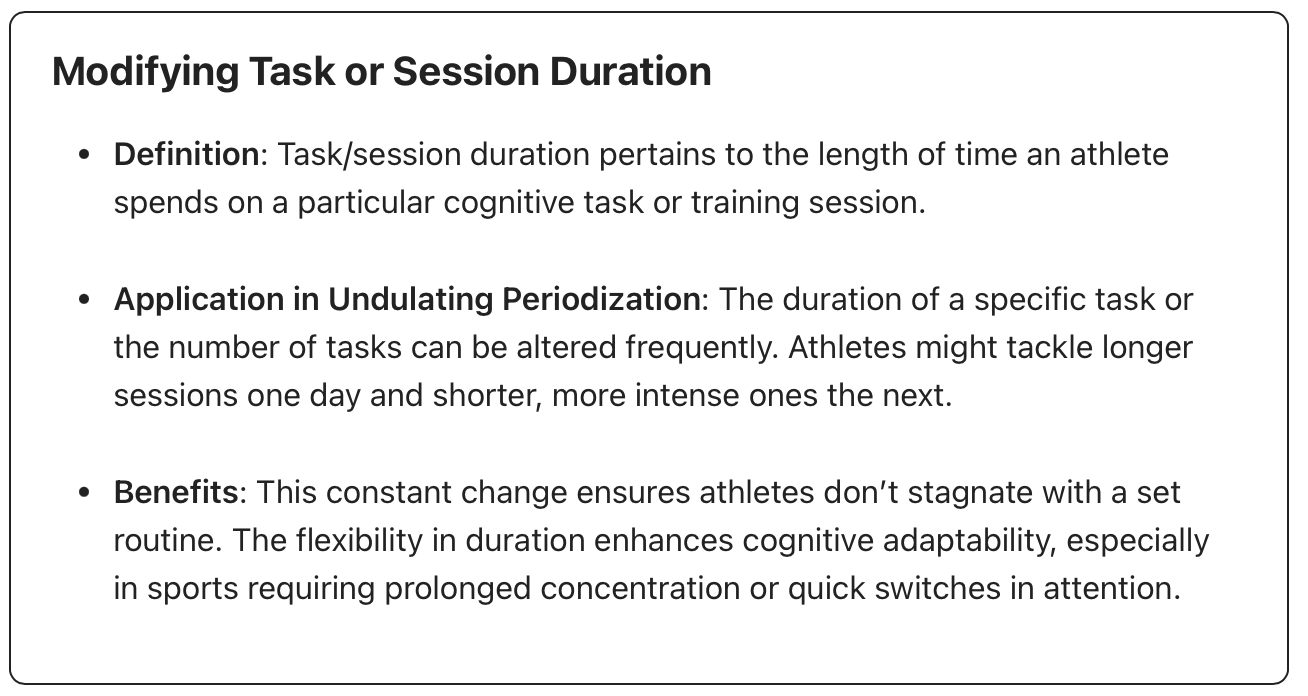
Duration is more than a mere measure of time; it signifies an individual's endurance and focus. In the world of sports, some moments elongate, as seen during a heated tennis rally, while others are fleeting, like a swift basketball counterattack. Undulating periodization captures this ebb and flow. Through the consistent alteration of task durations or their frequencies, athletes gear up for both the prolonged challenges and quick sprints in their respective sports, refining their aptitude to adapt on the fly.
Weekly Average Session Duration over a 4-Week Period
Week | Session Duration (minutes) |
Week 1 | 80 |
Week 2 | 20 |
Week 3 | 60 |
Week 4 | 40 |
Daily Variation of Session Duration over a Week
Days of the Week | Session Duration (minutes) |
Monday | 80 |
Tuesday | 20 |
Wednesday | 60 |
Thursday | 40 |
Friday | 60 |
Saturday | 20 |
Sunday | 80 |
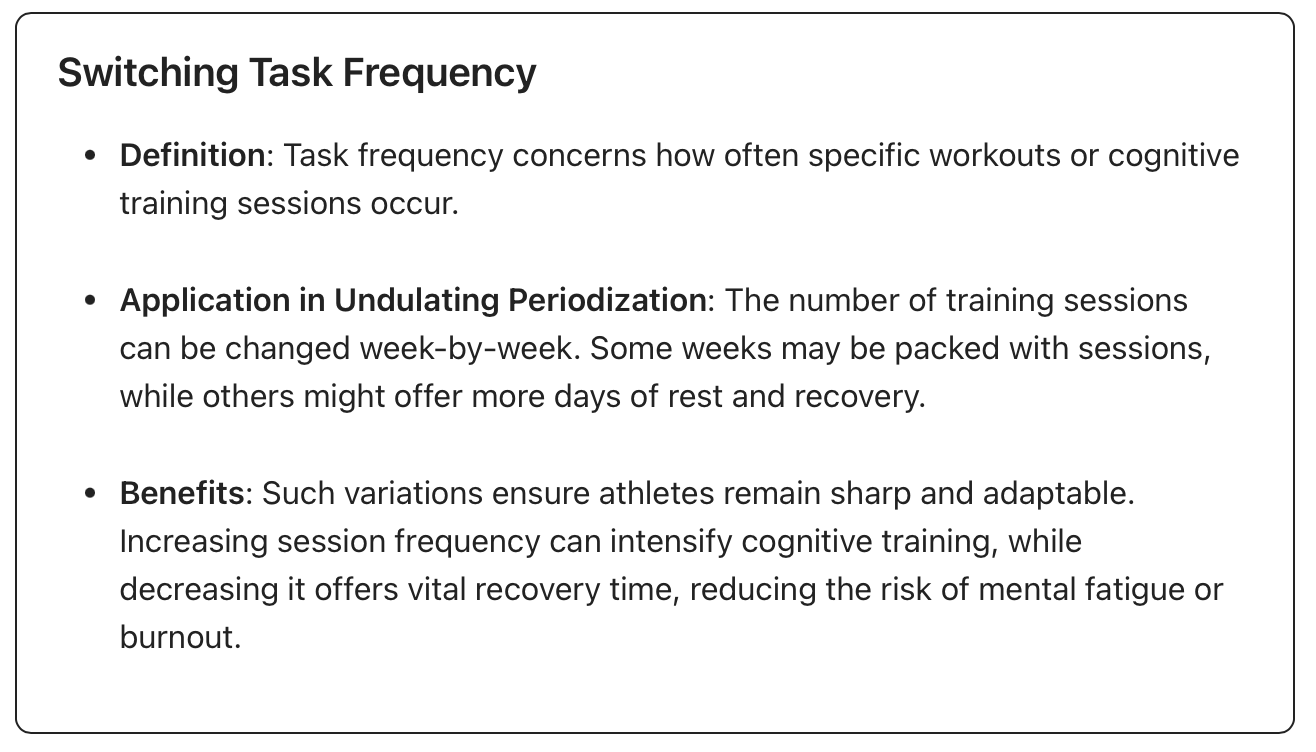
It isn't solely about the frequency but also about discerning the rationale behind it. Some weeks are intentionally dense, designed to bolster cognitive endurance and mirror situations where athletes may grapple with consecutive challenges. On the other hand, less intense weeks mirror phases of decreased exertion, underscoring the value of recuperation and tactical planning.
Undulating periodization revolves around the systematic variation of intensity and volume in short cycles, creating waves of training intensities instead of linear progressions. Key aspects include dynamic adaptation, where athletes constantly adjust to varying intensities, and diverse stimulus, offering both high-intensity, low-volume and vice-versa within short periods. The model also emphasizes micro-cycles, short frequently changing cycles that aid quicker recovery. For effective undulating periodization:
- Task Intensity: It's not just high vs. low but understanding the cognitive effort. Intensity should emulate real-world sports, reflecting the unpredictability of actual game scenarios.
- Task Duration: Beyond just time, it represents endurance and focus. The model captures the essence of sports moments, from prolonged challenges to quick sprints, training athletes to adapt swiftly.
- Task Frequency: It's about the rationale behind training frequency. Dense weeks improve cognitive endurance, while lighter weeks emphasize recovery and strategy.
In essence, undulating periodization is about continuous adaptation, ensuring athletes are always challenged and never stagnant.
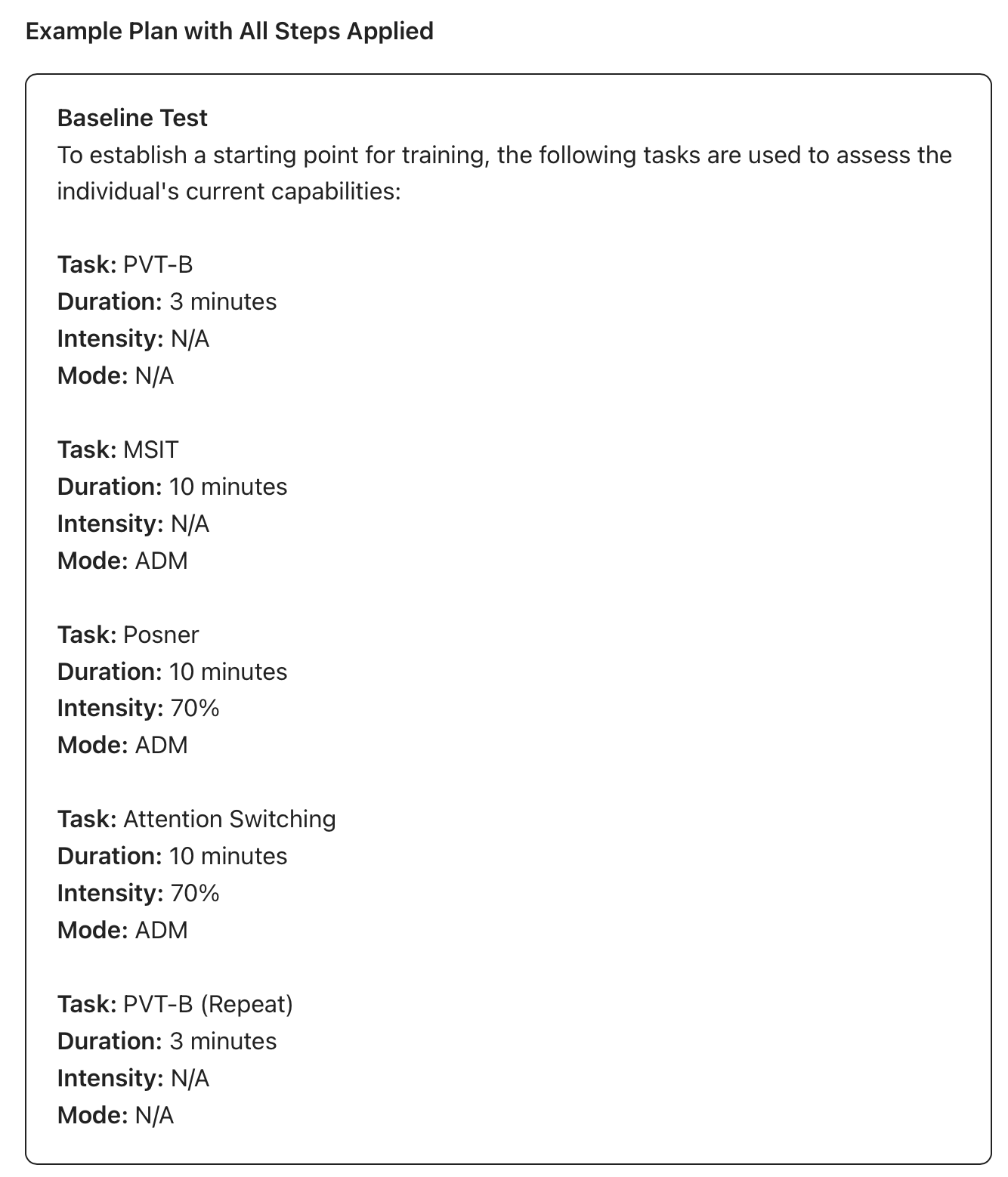
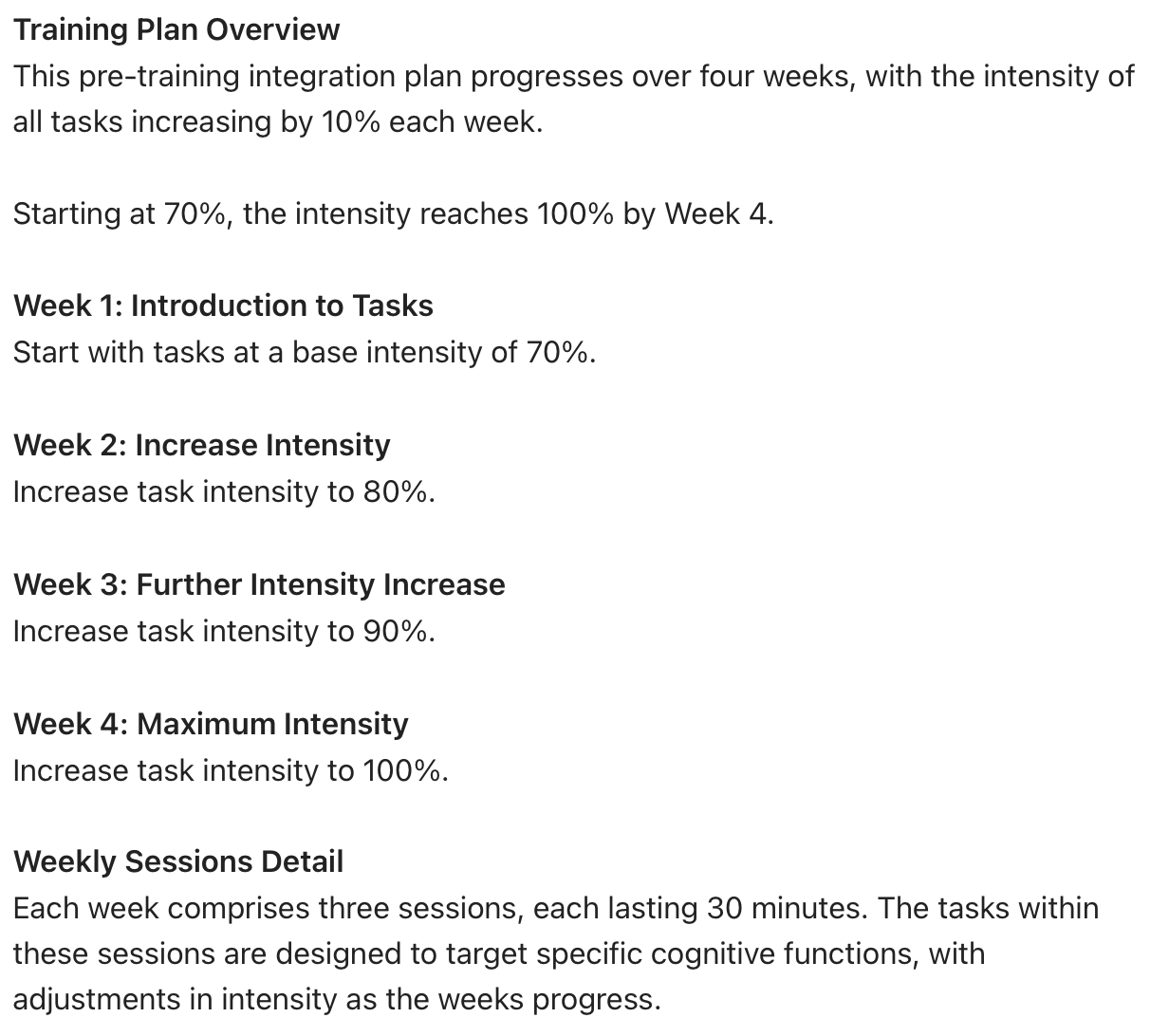
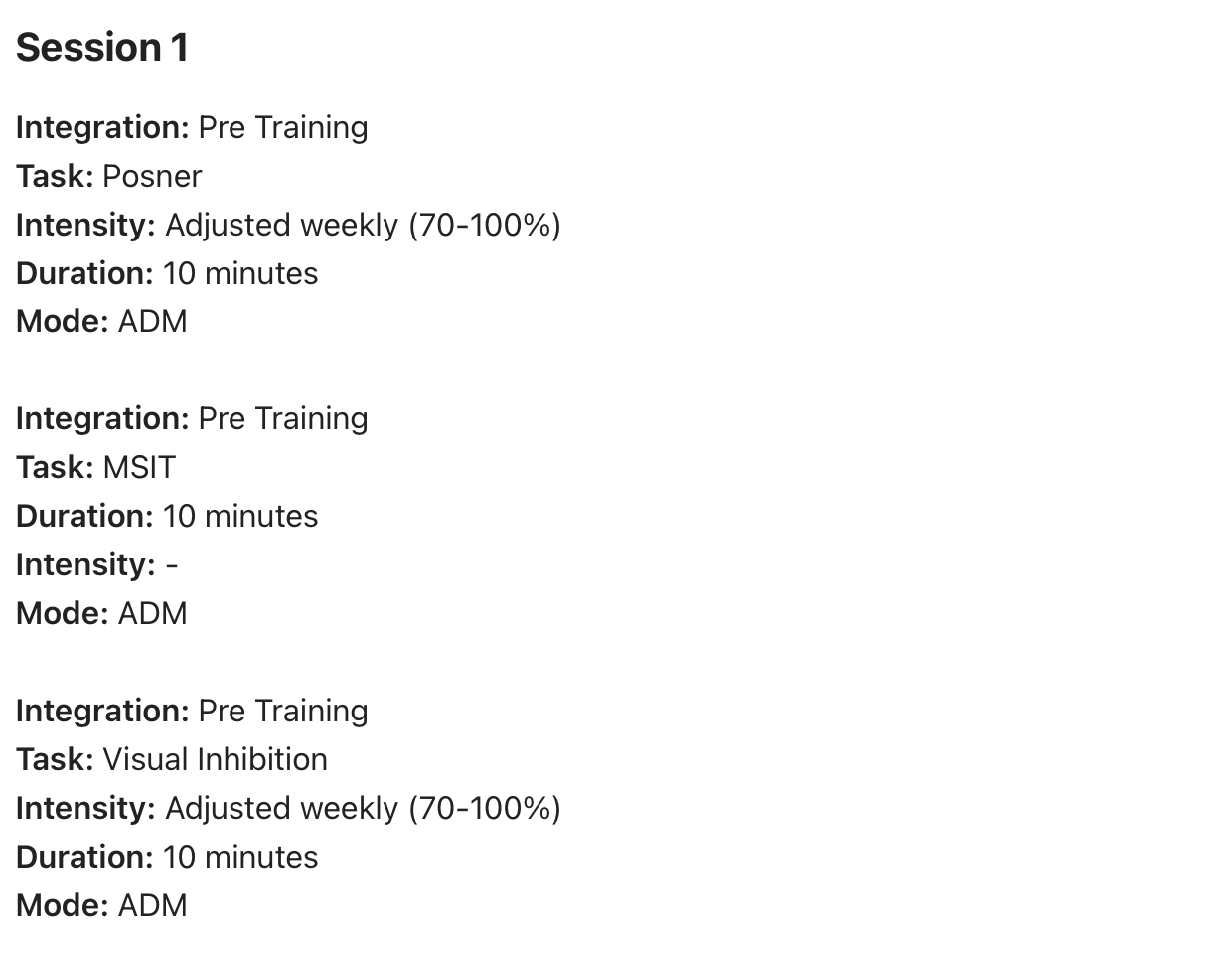
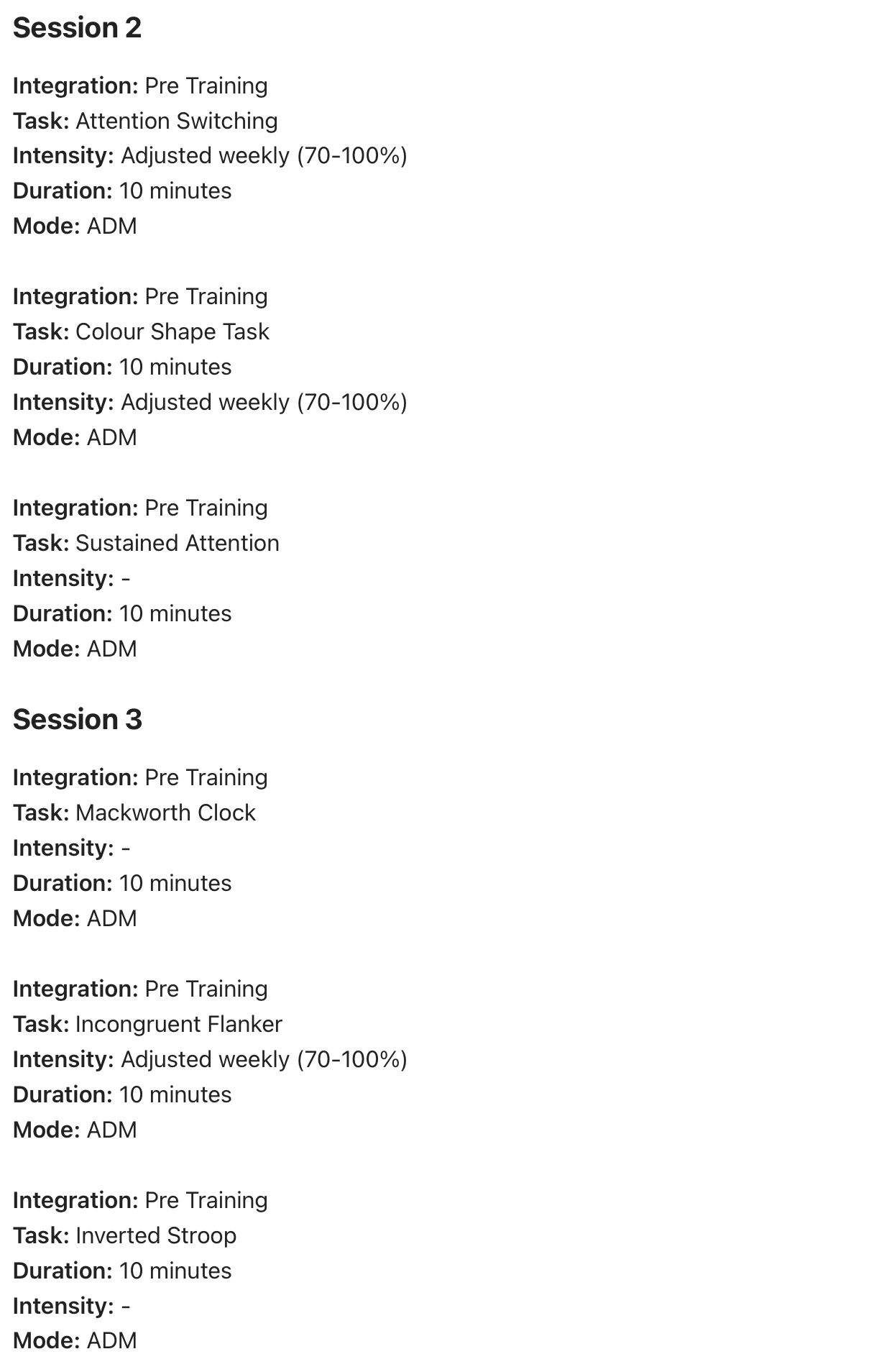
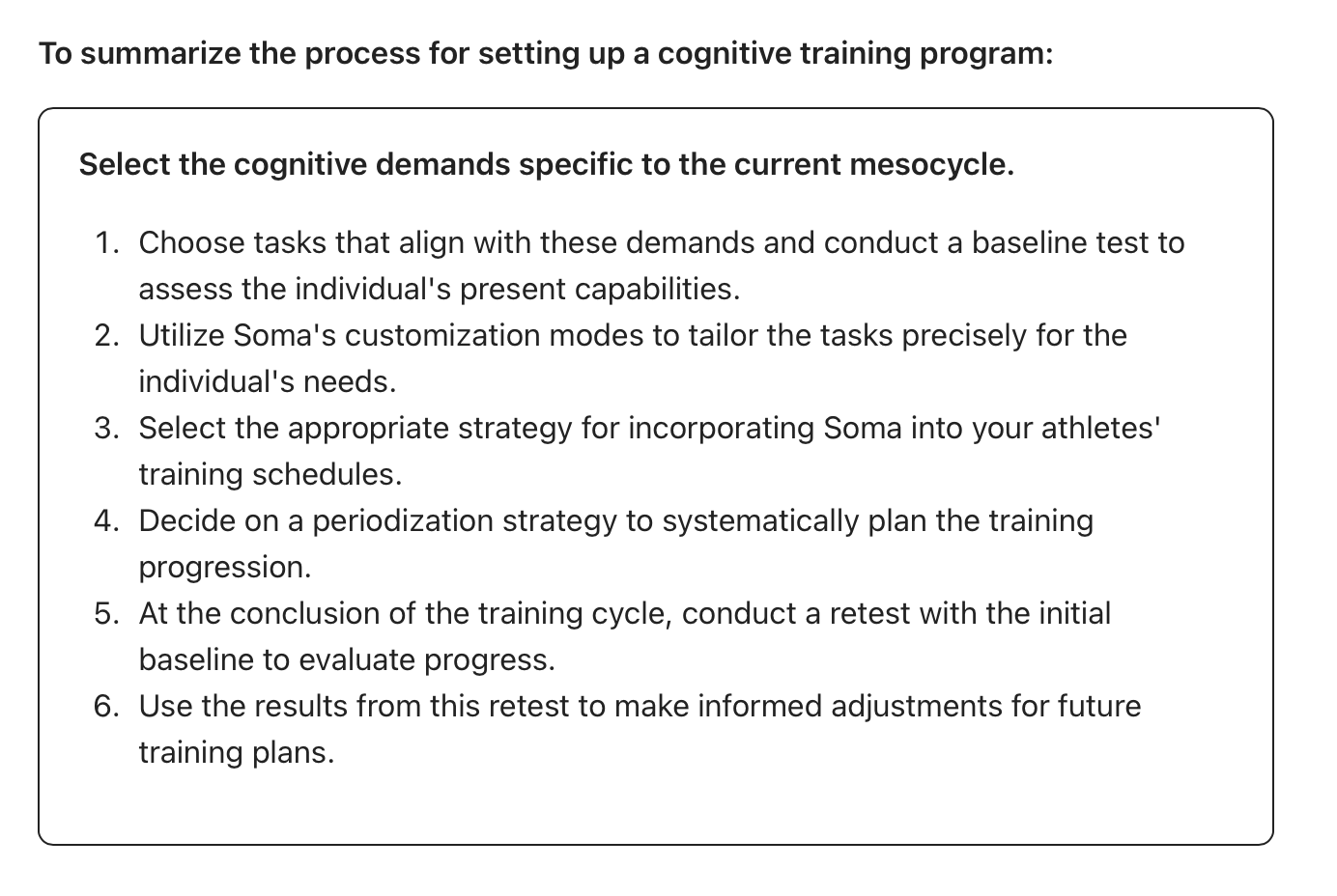
FAQs
How Long Should A Training Cycle Last?
The duration of a training cycle usually spans 4 to 6 weeks. However, it should be tailored to accommodate the specific requirements of the athlete and their training timetable.
How Often Should I Perform A Baseline Test?
We recommend conducting a baseline test at both the beginning and conclusion of each training cycle. However, if time is limited, you might opt for a baseline test every quarter instead.
Baseline Testing Per Training Cycle:
Week 1: Initial Baseline Test
Weeks 2 and 3: No tests
Week 4: Final Baseline Test
Baseline Testing Per Quarter:
Q1 (January): Baseline Test
Q2 (April): Baseline Test
Q3 (July): Baseline Test
Q4 (October): Baseline Test
This structure allows for flexibility in testing frequency based on time constraints and objectives of the training program.
🌐 Connect With Us
🌍 Soma Technologies: Engineered to enhance human performance.
📸 Instagram: Dive into our world through exclusive photos and stories.
👥 Facebook: Join our community for the latest updates and discussions.
📈 LinkedIn: Connect with us professionally and stay informed about industry news.
🎥 YouTube: Watch our latest videos, tutorials.
🐦 X: Follow us for instant updates, news, and engaging tweets.
